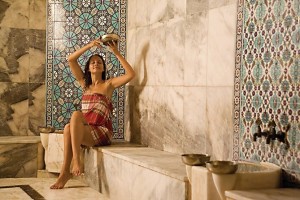Cappadocia Turkish Bath
Turkish Bath Cappadocia
Almost since the beginning of history, human beings have attributed divine qualities to the waters and used water resources as a means of purification. The Indians considered the Ganges river and the Egyptians the Nile sacred, and they were purified by washing themselves with the waters of these rivers.
Romans, bathed in the seas and rivers Over time these rituals began to be performed indoors, and they built the first baths with hot water and special heating systems. In fact, the first known public bath was the Stabia Bath in Pompeii City.
It is known that Turkish bath culture is based on the Uighurs. The bath tradition brought with them by the Turks who came to Anatolia combined with the tradition of the Romans and Byzantines, who were the inhabitants of Anatolia, and revealed the Turkish Bath culture.
The first bath known to the Ottomans was built in Bursa in 1336 by Orhan Bey. The first public bath was the Çemberlitaş Bath, which was built by Mimar Sinan by Nurbanu Sultan, the mother of Murat I, in 1584. .
The Turkish Bath, which is the most colorful element of Turkish National Culture, still continues its existence even though it has been partially changed. In addition to the original Turkish baths, whose numbers are so few as to be shown with a finger today, the hammam, which is an interesting element of accommodation establishments in touristic destinations, has a special importance in terms of Turkish cultural heritage.
In the baths, which are organized in line with many different traditions such as the Bride's Bath, the groom's bath, and the baby bath, was especially the places where women who do not leave the house much, socialize, doing their cleaning and care are done for a day accompanied by the meals they eat and the sherbets.
The materials used in the bath culture are also a cultural element in itself. Nalıns; It is a kind of shoe that reflects the economic situation of its owners, some silver plated, some mother-of-pearl and ivory inlaid, owned by women from all walks of life during the Ottoman period. Soaps are also very important. Those who gave the invitation to the bath would make special scented soaps and invite the guests with soap. Towels with embroidered, cotton woven ends, embroidered with colored silk, thread and glitter were a must for the bridal bath bundles. One of the the bath bundle is the bath bowls, some of which are made of silver and some of tin, but with different motifs on them. Like other materials, since the bath bowl symbolizes the taste, existence and social status of its owner, silver and specially made ones were used by special people on special occasions.
Especially in recent years, the Turkish bath culture has come to the fore with the understanding of offering alternative tourism products to tourists who are tired of the classical tourism understanding and are in search of new ones. The baths designed are offered to the tourism consumer.
Cappadocia Turkish Hammam
Almost since the beginning of history, human beings have attributed divine qualities to the waters and used water resources as a means of purification. The Indians considered the Ganges river and the Egyptians the Nile sacred, and they were purified by washing themselves with the waters of these rivers.
Romans, bathed in the seas and rivers Over time these rituals began to be performed indoors, and they built the first baths with hot water and special heating systems. In fact, the first known public bath was the Stabia Bath in Pompeii City.
The Turkish Bath, which is the most colorful element of Turkish National Culture, still continues its existence even though it has been partially changed. In addition to the original Turkish baths, whose numbers are so few as to be shown with a finger today, the hammam, which is an interesting element of accommodation establishments in touristic destinations, has a special importance in terms of Turkish cultural heritage.
Especially in recent years, the Turkish bath culture has come to the fore with the understanding of offering alternative tourism products to tourists who are tired of the classical tourism understanding and are in search of new ones. The baths designed are offered to the tourism consumer.

